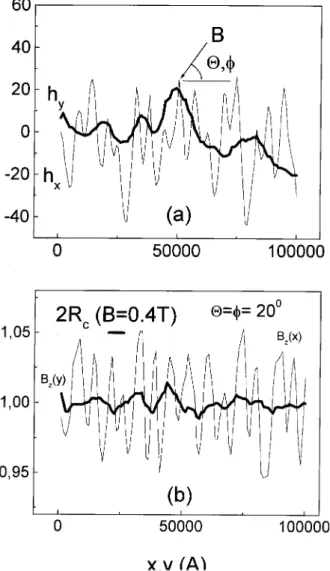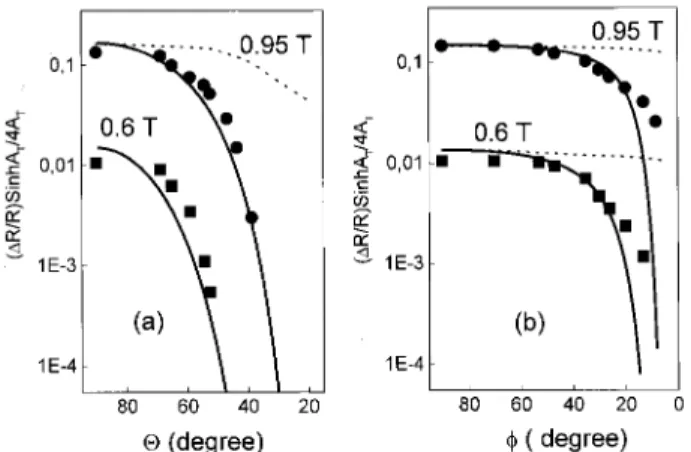Brazilian Journal of Physics, vol. 29, no. 4, December, 1999 711
Magnetotransport in a Spatially Modulated
Magnetic Field
G.M.Gusev,A. A. Quivy,J.R.Leite,
Instituto de Fisica da Universidade de S~ao Paulo, CP 66318, CEP 05315-970, S~ao Paulo, SP, Brazil
A. A. Bykov, N.T.Moshegov, V.M.Kudryashev,A.I.Torop ov, and Yu.V.Nastaushev
Institute of Semiconductor Physics, Russian Academy of Sciences, Siberian Division, Novosibirsk, Russia
Received February 6, 1999
We have measured the Shubnikov de Haas (SdH) oscillations of a nonplanar two-dimensional elec-tron gas (2DEG) fabricated by overgrowth of a GaAs/AlGaAs heterojunction on a pre-patterned substrate. When placed in a uniform external magnetic eld B, the eld normal to the nonplanar 2DEG is spatially modulated, and electrons experience a nonuniform magnetic eld. In a tilted magnetic eld, the SdH oscillations are much more strongly damped than in a eld perpendicular to the substrate. We consider several mechanisms and conclude that the electron scattering by the magnetic eld spatial uctuations plays a main role in the transport properties of a nonplanar 2DEG at low magnetic eld.
Recently, new regrowth techniques have been re-ported to produce a two-dimensional electron gas (2DEG) on nonplanar pre-patterned GaAs substrates [1,2]. The interest in fabricating such systems is gen-erated by the possibility to investigate the physics of electron motion in a nonuniform magnetic eld. Since a 2DEG is sensitive to only the normal component of the magnetic eld B, electrons conned to a nonplanar het-erojunction experience nonuniform magnetic eld vary-ing with position, dependvary-ing of the surface shape, if an uniform B is applied to such nonplanar surface.
This letter reports on the fabrication of 2DEG on a nonplanar stripe-shaped surface with small heights of the stripes. The 2DEG has the mobility of (250-400)10
3cm2/Vs at a carrier density of 5.4 10
11cm,2. We studied the electron transport properties of nonpla-nar 2D electrons in a magnetic eld.
Fig. 1a shows the prole of the surface in the direction along the stripes (x direction) and across the stripes (y direction) measured by atomic force microscopy. Along the x direction we can see both irregular and periodical components in the surface cor-rugation. The average periodicity is coincident with the antidot lattice periodicity before overgrowth. The corrugation height h varies between 20 and 65 A. Fig. 1a shows also a irregular surface prole along the y
direction with smaller corrugation height and larger average periodicity than along the x direction. The origin of these irregularities in not understood. The patterned area was 140140m
2. After regrowth, the HEMT structure was processed into Hall bars, and the nonplanar surface was situated on the one side of Hall bar (see insert of g 2). As was mentioned before, since 2DEG is sensitive only to the normal component of B, measuring the resistance for dierent angles between the eld and the normal to the substrate surface allows us to vary the magnitude of the magnetic eld uctua-tions. If magnetic eld is tilted away from the normal to the substrate, the normal component of B can be expressed as
BN(x;y;z) = (B
5f)=j5f j ; (1) where gradient5f( df/dx, df/dy, df/dz) is dened for the surface f(x;y;z) = 0. In realistic samples we have df=dyh=d << 1. Therefore, if the external magnetic eld is tilted in the y direction, the expression (1) can be rewritten as BN
Bsin + (df/dy) BcoshB N
i+ B(x), where is the angle between the external mag-netic eld and the substrate plane, hB
N
i = Bsin is the average normal component of B. At angles >> h/d 1
o , the average magnetic eld hB
N
712 G.M.Gusevet al. B(x). Fig. 1b shows the magnetic eld prole when
the external eld is tilted in the x or in y direction. Fig.2 shows the longitudinal magnetoresistance of the one typical sample for dierent angles and between the eld and the normal to the substrate plane as a function of the magnetic eld component BN perpen-dicular to the substrate. The magnetic eld was tilted in the x (a) and y direction (b). At a magnetic eld 0.4 T, the SdH oscillations are clearly seen. The oscilla-tions are shifted towards higher total eld, following, as expected, a (sin),1 law. However, as B is tilted from the normal, SdH oscillations are more strongly damped than for the perpendicular eld. This damping is much stronger when B is tilted away from the normal in the y direction (a) than in the x direction (b).
Figure 1. a) Prole of the surface along the x and y direc-tion of the sample shown in g.1b .
b) Magnetic -eld prole calculated for the surface prole shown in g.2a when the magnetic eld is tilted in the x (thick line) or y (thin line) direction. Bars-cyclotron diam-eter at 0.4 T.
In the 2D case, the amplitude of the SdH oscillations
is given by [3]:
R=R = (4AT=sinhAT)exp( ,=!
cs)cos(2 2
~n s=eB)
(2) where AT= 2
2kT/ ~!
c , s is a single-particle relax-ation time which is typically 10-100 times smaller than the momentum relaxation time extracted from the mo-bility measurements at B=0 [4]. Fig.3 a, b shows the amplitude of the magnetoresistance oscillations as a function of the tilt angles and , when B is tilted away from the normal, consequently, in the y and x di-rections, for two values of magnetic eld 0.6 and 0.95 T. We should note, that in the planar 2DEG the mag-nitude of SdH oscillations does not change ( within the accuracy of 10%). Therefore, the observed decrease of the SdH amplitude with the angle in our nonplanar samples can be attributed to the uctuations of mag-netic eld arising from the surface corrugation, as seen in AFM image.
Figure 2. Magnetoresistance as a function of the magnetic eld component perpendicular to the substrate for dierent angles between the applied magnetic eld and the normal to the substrate at T=1.5 K. The insets show a schematic view of the experimental geometry. a) : 90
o (thin line), 53o (thick line), 20o (dotted line), 10o (dashes).
b): 90
o (thin line), 38o (thick line), 20o(dotted line), 12o (dashes).
The several eects can be responsible for the damp-ing of the SdH oscillations in the tilted magnetic eld. At small magnetic eld the cyclotron diameter 2Rc=2vF/!c (vF-Fermi velocity, !c=eB/mc- cyclotron frequency) is larger than magnetic periodicity. For ex-ample, g. 1b shows the size of the cyclotron circle at B=0.4 T, when SdH oscillations start to appear. Mag-netic eld is no longer homogeneous inside of the cir-cular orbit, hB
N
Brazilian Journal of Physics, vol. 29, no. 4, December, 1999 713 the cyclotron diameter becomes smaller than magnetic
periodicity. In this case average magnetic eld, and, consequently, the cyclotron energy of the orbits depend on their position. It also leads to the additional broad-ening of Landau levels and SdH oscillations. Finally, it has been assumed that the damping factor of the SdH oscillations is governed by localization eects [6]. If the magnetic eld is strong, the particles can drift along the percolation trajectories with zero hBNi. The number of such trajectories decreases with decreasing B, which also leads to the extremely sharp fallo of the amplitude of the oscillations.
Figure 3. Amplitude of the SdH oscillation at xed nor-mal component of magnetic eld as a function of tilt angle, when the magnetic eld is tilted in x (a) and y directions (b). Thick lines- equations (3-5) calculated for realisitic surface prole (g.2a). Dashed lines- equation (2) with position de-pendent lling factor calculated for realistic surface prole.
A theoretical model of electron transport in a ran-dom short-range and long -range magnetic potential (in the presence of additional uniform magnetic eld) has been reported in [5]. In contrast to the typical case of impurity random potential (equation 2) it was obtained that R
exp[-4/(!
cm)4 ] when the average period-icity of the magnetic- eld uctuations d is much larger than the cyclotron diameter 2Rc , and that
R
exp[-2/(!
cm)2] for short correlation lentgh d<<2Rc, where m is a single-particle relaxation time
due to the random magnetic eld. Because in our case the magnitude of the magnetic eld uctuations is pro-portional to the external magnetic eld (see eq.(1)), it leads to dependencies R
exp[-2/(!
cm)2] for d>> 2Rcand Rexp[-/(!cm) ] for d<< 2Rc. More de-tailed calculations are presented elsewhere [7]. Taking into account that the impurity electric eld and nonuni-form magnetic eld induce the random phase along the classical paths independently, it leads to the following damping of the SdH oscillations in the presence of im-purities and random magnetic potentials [7]:
Rexp[- /(!cs)-/(!cm)] (3) 1/m = (23m3v3
Fc3/e3 0
2) hB
2 i/hBNi
3 (4) , where 0=hc/e.
Substituting equation (1) into formula (4) and taking into account that
hB 2
i/hBNi 3
hdf=dy 2
i(ctg) 2(d/2R
c)(1/hBNi), we nd
1/m(1/ 0)
2(d/v
F)hdf=dy 2
i(ctg) 2 (5) ,
where 0=h/EFis characteristic time of 2DEG . We cal-culate 1/mfor realistic prole of the surface measured
by AFM (g.1b,c) and substitute it into the equation (3) in order to compare our theoretical estimation with experimental results. Single particle relaxation time due to impurity scattering 1/swe nd from the
Din-gle plot ( lnR/R vs 1/B) in perpendicular B, when magnetic uctuations are very small, and we can ne-glect magnetic scattering. Fig. 3 a , b shows results of calculations. We see that the theoretical curves t ex-perimental results very well without any adjustable pa-rameters for both cases, when magnetic eld are tilted in x and y directions.
When magnetic eld is tilted in the y direction cyclotron diameter is smaller than magnetic period-icity even at B=0.6 T , and for comparison our the-oretical model with experimental results we calculate time (m using equation (4) . If 2Rc<d the additional
mechanism-broadening due to the spatial uctuation of Landau level factor should be also taken into account. In order to compare this mechanism with experimental results we calculate the amplitude of the SdH oscilla-tions considering realistic prole of magnetic eld ( g.1 b). Results of these calculations are shown in g. 3 a ,b by dotted line. We see, that this eect is smaller than the damping of SdH oscillations due to the magnetic scattering, and we can neglect it. However, we should note that at stronger magnetic eld and for smaller tilt angle this inhomogeneous broadening of Landau levels can play an important role.
In summary, we report the fabrication of the non-planar stripe-shaped 2DEG with small amplitude of the surface corrugation. By rotating the sample in an external magnetic eld, we demonstrate that the nonplanar 2DEG has transport properties, which are dierent from planar 2DEG. In particular, a strong damping of the SdH oscillations is found in tilted mag-netic eld. This damping arises from the additional electron scattering by a nonuniform magnetic eld.
References
[1] M.L. Leadbeater, C.L. Foden, J.H. Burroughes, M. Pepper, T.M. Burke, L.L. Wang, M.P. Grimshaw, D.A. Ritchie, Phys. Rev. B,52, R8628 (1995).
[2] G.M. Gusev, U. Gennser, X. Kleber, D.K. Maude, J.C. Portal, D.I. Lubyshev, P. Basmaji, M.de P.A. Silva, J.C. Rossi, Yu.V. Nastaushev, Surface Science, 361/362, 855 (1996).
[3] T. Ando, J. Phys. Soc. Jpn,37, 1233 (1974).
[4] P.T. Coleridge, R. Stoner, R. Fletcher, Phys. Rev. B, 39, 1120 (1989).
[5] A.G. Aronov, E. Altshuler, A.D. Mirlin, P. Wolfe, Eu-rophys. Lett., 29, 239 (1995); A.G. Aronov, E. Alt-shuler, A.D. Mirlin, P. Wolfe, Phys. Rev. B, 52, 4708 (1995).
[6] A.D. Mirlin, D.G. Polyakov, P. Wolfe, Phys. Rev. Lett., 80, 2429 (1998).

